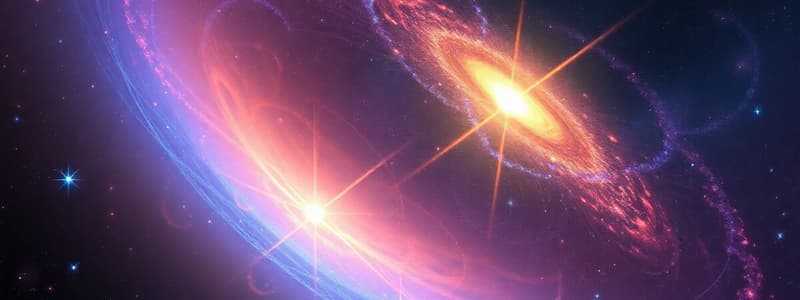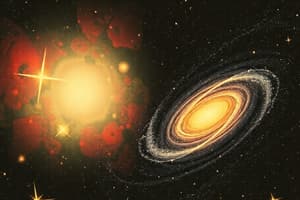Podcast
Questions and Answers
What is the primary role of the first stars in galactic evolution?
What is the primary role of the first stars in galactic evolution?
- They help stabilize existing star clusters.
- They chemically enrich the interstellar medium with heavy elements. (correct)
- They increase the density of the intergalactic medium.
- They create dark matter necessary for galaxy formation.
How does the lifespan of a star primarily depend on its characteristics?
How does the lifespan of a star primarily depend on its characteristics?
- It is determined by its gravitational pull on surrounding objects.
- It is dependent on the mass of the star and the amount of hydrogen present. (correct)
- It changes with the star's distance from other celestial bodies.
- It correlates with the star's position in the galaxy.
What occurs during the process of re-ionization in the universe?
What occurs during the process of re-ionization in the universe?
- Collapsing of gas clouds to form black holes.
- Ionization of surrounding neutral hydrogen gas by ultraviolet radiation. (correct)
- Merging of galaxies leading to increased star birth.
- Formation of new stars from dark matter halos.
What is one consequence of the supernova explosions of the first massive stars?
What is one consequence of the supernova explosions of the first massive stars?
What distinguishes how massive stars end their lifecycle compared to less massive stars?
What distinguishes how massive stars end their lifecycle compared to less massive stars?
What was a key characteristic of the first stars in the universe?
What was a key characteristic of the first stars in the universe?
What could have potentially evolved into the first stars following the Big Bang?
What could have potentially evolved into the first stars following the Big Bang?
What significant role did the first stars play in the evolution of the solar system?
What significant role did the first stars play in the evolution of the solar system?
How do scientists study the final days of the cosmic dark ages?
How do scientists study the final days of the cosmic dark ages?
What distinguishes protogalaxies from modern galaxies?
What distinguishes protogalaxies from modern galaxies?
Which of the following is true about quasars?
Which of the following is true about quasars?
What element was predominant in the early universe before the formation of stars?
What element was predominant in the early universe before the formation of stars?
What can be inferred about star formation systems during the era of protogalaxies?
What can be inferred about star formation systems during the era of protogalaxies?
What is Jeans mass in relation to the formation of galaxies?
What is Jeans mass in relation to the formation of galaxies?
Which process occurs after a cloud of dust and gas forms a protostar?
Which process occurs after a cloud of dust and gas forms a protostar?
What does the process of accretion involve for a protostar?
What does the process of accretion involve for a protostar?
Which feature is characteristic of the life cycle of a star starting from a protostar?
Which feature is characteristic of the life cycle of a star starting from a protostar?
What happens when the protostar gains enough mass?
What happens when the protostar gains enough mass?
What is the significance of galaxy clusters in the context of protogalaxies?
What is the significance of galaxy clusters in the context of protogalaxies?
What triggers the process of thermonuclear fusion in stars?
What triggers the process of thermonuclear fusion in stars?
What is a protostar a precursor to in stellar evolution?
What is a protostar a precursor to in stellar evolution?
What characteristic is NOT necessary for an object to be classified as a planet?
What characteristic is NOT necessary for an object to be classified as a planet?
Which process involves the breakdown of atomic nuclei into simpler components?
Which process involves the breakdown of atomic nuclei into simpler components?
What type of nucleosynthesis primarily occurs during the life cycle of stars?
What type of nucleosynthesis primarily occurs during the life cycle of stars?
Which elements were primarily formed during Big-bang Nucleosynthesis?
Which elements were primarily formed during Big-bang Nucleosynthesis?
What is the correct order of the planets in our solar system starting from the closest to the sun?
What is the correct order of the planets in our solar system starting from the closest to the sun?
What is the minimum condition required to form heavier elements through supernova nucleosynthesis?
What is the minimum condition required to form heavier elements through supernova nucleosynthesis?
During which phase of planetary formation do larger dust aggregates form?
During which phase of planetary formation do larger dust aggregates form?
Which process involves massive planetesimals attracting significant gas from the protoplanetary disk?
Which process involves massive planetesimals attracting significant gas from the protoplanetary disk?
What primarily causes planetesimals to merge in the inner regions of the protoplanetary disk?
What primarily causes planetesimals to merge in the inner regions of the protoplanetary disk?
What occurs during the 'clearing the disk' phase of planetary formation?
What occurs during the 'clearing the disk' phase of planetary formation?
What are the building blocks of gas giant planets during their formation?
What are the building blocks of gas giant planets during their formation?
Which of the following is NOT part of the planetary formation process?
Which of the following is NOT part of the planetary formation process?
In the context of solar system formation, what role do smaller bodies like asteroids and comets play?
In the context of solar system formation, what role do smaller bodies like asteroids and comets play?
Flashcards are hidden until you start studying
Study Notes
The First Stars In The Universe
- The first stars were massive and luminous. This led to the production and dispersion of heavier elements, which in turn led to the formation of the solar system as we know it today.
- Density fluctuations left over from the Big Bang could have evolved into the first stars.
- Distant quasars helped scientists glimpse into the final stages of the Cosmic Dark Ages.
- Quasars are luminous and distant celestial objects that emit a vast amount of electromagnetic radiation. They are thought to be powered by supermassive black holes at the centers of galaxies.
- Stars with high masses are more luminous and have a shorter lifespan compared to smaller stars.
Formation of Protogalaxies
- A star-forming system is much smaller and less organized than a modern galaxy.
- It does not contain a significant amount of any elements besides hydrogen and helium.
- Protogalaxies merge to form galaxies and then gather into galaxy clusters.
- Jeans mass is the minimum mass a clump of gas must have to collapse under its own gravity.
Formation of Protogalaxies: Step by Step
- Clouds of gas and dust slowly aggregate to form more matter.
- As they evolve, these clouds merge with each other, forming larger structures like the galaxies we see today.
How Are Stars Formed?
- Stars originate from a cloud of dust and hydrogen gas called a nebula.
- A hot core forms from the collection of dust and gas, which becomes a protostar.
- The protostar grows by adsorbing more material from its surroundings, a process called accretion. This increases its temperature and density.
- Hydrogen molecules within the protostar begin to react, forming Helium gas through thermonuclear fusion.
- With enough mass and energy, the protostar collapses into its own gravitational force, forming a hot ball of gas, becoming a star.
Role of First Stars: Re-ionization, Chemical Enrichment, and Galactic Evolution
- The first stars emitted ultraviolet radiation, ionizing surrounding neutral hydrogen gas in the universe. This led to the process of re-ionization.
- The first stars ended their lives in powerful supernova explosions, releasing heavy elements into surrounding gas clouds. This chemically enriched the interstellar medium, allowing for the formation of later generations of stars, planets, and complex molecules necessary for life.
- The presence of metals within the interstellar medium made it easier for subsequent generations of stars to form planets and other structures, ultimately contributing to galactic evolution.
Classification of Stars
- Stars are classified based on their surface temperature and luminosity.
Categories of Star Formation
- Microphysics: Deals with how individual stars form.
- Macrophysics: Deals with how systems of stars form, ranging from clusters to galaxies.
Lifespan of Stars
- The lifespan of a star depends on the amount of hydrogen present.
- When all the hydrogen is consumed, the star dies.
- Less Massive Stars: Emit stellar material into space, leaving behind a white dwarf surrounded by a planetary nebula.
- Massive Stars: Blast matter into space in a bright supernova, leaving behind a dense neutron star.
- Most Massive Stars (3x the mass of the sun): Collapse into themselves, creating a black hole.
Formation of Planets: Our Solar System
- The solar system is composed of a star, eight planets, and numerous smaller bodies like dwarf planets, asteroids, and comets.
- Planets are ordered outward from the Sun: Mercury, Venus, Earth, Mars, Jupiter, Saturn, Uranus, Neptune.
Planetary Formation: Step by Step
- Protoplanetary Disk Formation: A rotating disk of gas and dust is formed.
- Dust Grain Growth: Dust grains collide and stick together due to van der Waals forces, forming larger particles.
- Planetesimals Formation: Larger dust aggregates accumulate, forming larger objects called planetesimals, which continue to grow through collisions and gravitational interactions.
- Protoplanetary Cores Formation: Massive planetesimals attract significant amounts of gas from the protoplanetary disk, forming the building blocks of gas giant planets.
- Terrestrial Planet Formation: Planetesimals collide and merge in the inner regions of the protoplanetary disk, closer to the sun.
- Clearing the Disk: Protoplanets interact with surrounding gas, either accreting more material or clearing out their paths.
- Dwarf Planet: A dwarf planet is unable to clear its orbit of debris, such as Pluto.
Characteristics of a Planet
- Orbits the Sun
- Not a moon
- Enough mass to be round
- Able to clear its orbit of debris
Nucleosynthesis
- It is the process of forming new atomic nuclei from existing smaller nuclei.
- It can occur through the combination of light elements or the breakdown of heavier elements.
- Nuclear Fusion: The combination of two or more atomic nuclei to form one or more new atomic nuclei.
- Nuclear Fission: The breakdown of a nucleus into two or more separate nuclei.
Types of Nucleosynthesis: Big Bang, Stellar, and Supernova
- Big-Bang Nucleosynthesis: Lighter elements (H and He, traces of Li, Be, and B) formed within the first 3 minutes to 300,000 years after the Big Bang.
- Stellar Nucleosynthesis: Elements from some He to Fe are synthesized in young stars through fusion, requiring extreme temperatures at the core.
- Supernova Nucleosynthesis: Heavier elements are formed during supernova explosions of stars, occurring under conditions of extremely high temperatures (100 billion degrees Celsius) and abundant neutrons.
Studying That Suits You
Use AI to generate personalized quizzes and flashcards to suit your learning preferences.




